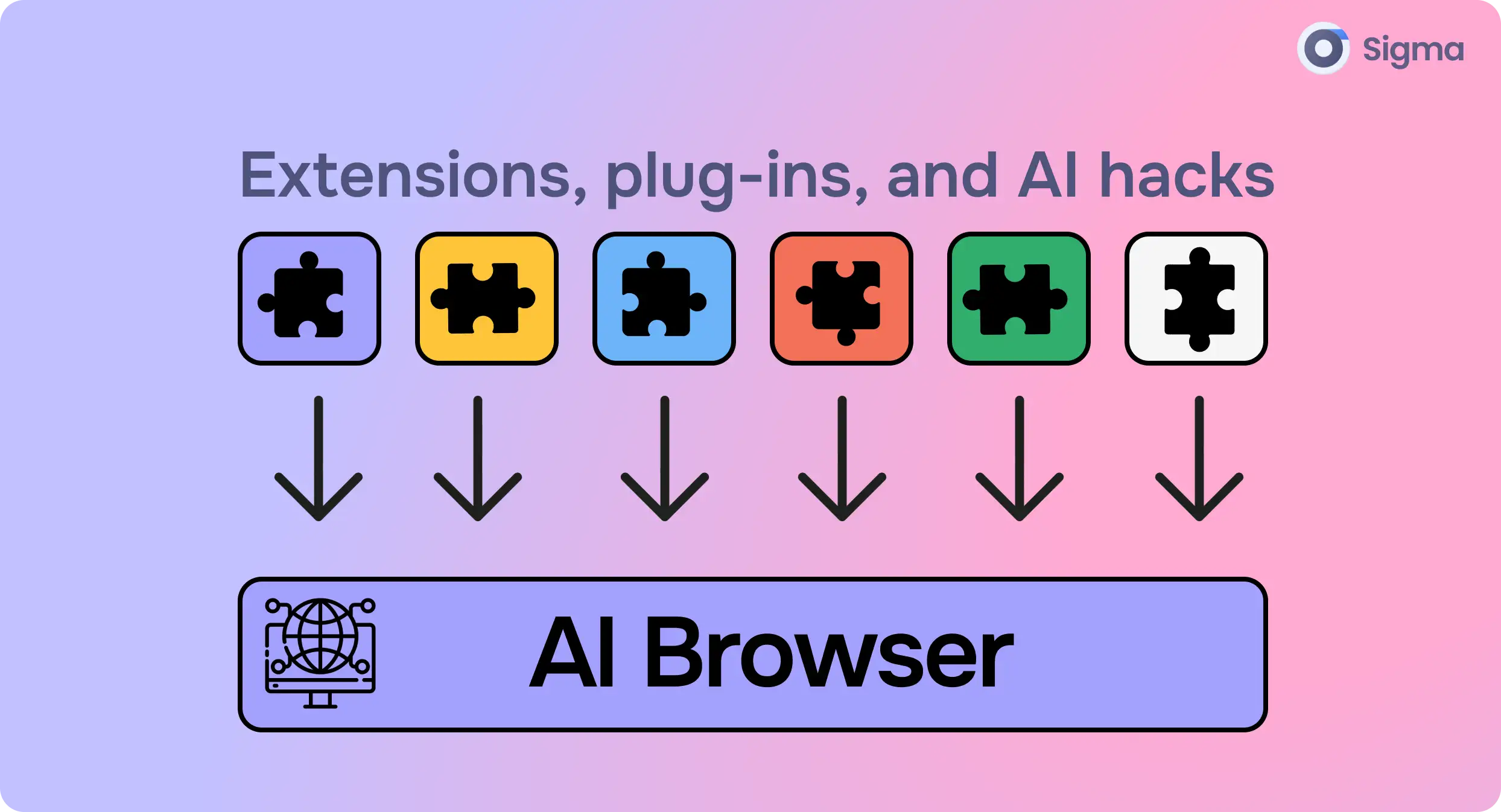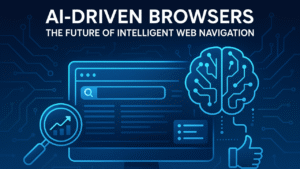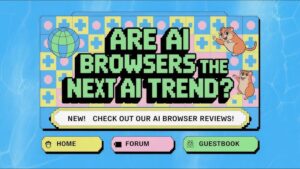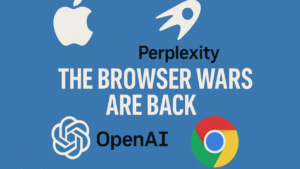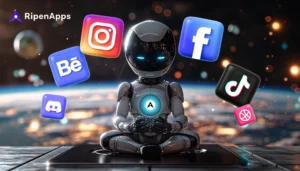New AI Browsers: Redefining the Way We Surf the Web
Introduction
For decades, web browsers have been our gateway to the internet—helping us search, browse, and interact with online content. From the early days of Netscape and Internet Explorer to the dominance of Chrome, Firefox, Safari, and Edge, browsers have largely remained utility-driven: they render websites, store bookmarks, manage cookies, and allow extensions. But in 2025, we are seeing a radical shift. New AI browsers are emerging, powered by generative AI, multimodal agents, and deep personalization.
These next-gen browsers are not just static portals to information; they are becoming active assistants that understand intent, summarize content, generate insights, automate tasks, and even make decisions. The rise of AI-native browsers like Arc, Opera’s AI upgrades, Microsoft Edge with Copilot, and independent players like SigmaOS, Sidekick, and Hyperweb shows a clear trajectory: browsers are evolving into personalized AI-driven digital workspaces.
This article explores the concept of new AI browsers, their key features, how they differ from traditional browsers, the major players in the space, their implications for work and daily life, and what the future holds.
The Evolution of Browsers
To understand the significance of AI browsers, it’s helpful to look at the three major eras of browsing:
-
Static Browsing Era (1990s–2000s):
Browsers were primarily page renderers. Internet Explorer and Netscape dominated, offering basic navigation and bookmarks. -
Dynamic & Extension Era (2010s):
Chrome led the way with speed, extensions, and developer tools. Firefox, Safari, and Opera competed with performance and privacy features. Browsers became customizable ecosystems. -
AI-Augmented Era (2023 onwards):
With the rise of ChatGPT, Copilot, and Gemini, AI capabilities started embedding into browsers. Summarization, smart search, and contextual answers became common. Now, AI browsers are moving beyond plugins—becoming AI-first environments where human-AI collaboration defines the browsing experience.
What Are AI Browsers?
AI browsers are web browsers integrated with artificial intelligence at their core. Instead of just displaying websites, they actively assist users by:
-
Understanding intent: If you type “best laptops under $1000,” the browser doesn’t just show links; it can compare specs, summarize reviews, and suggest options.
-
Generating content: From emails and reports to blog posts, AI browsers can create text, images, and even code directly inside the browsing interface.
-
Summarizing and analyzing: Long articles, PDFs, research papers, or even video transcripts can be instantly condensed into easy-to-digest insights.
-
Personalizing experiences: AI learns user behavior and tailors recommendations, bookmarks, and workflows.
-
Automating workflows: From filling forms and managing documents to booking flights and drafting contracts, AI agents inside browsers act as personal assistants.
In essence, the new AI browser is half web navigator, half productivity tool, and half digital assistant.
Key Features of New AI Browsers
1. AI-Powered Search
Instead of 10 blue links, AI browsers integrate conversational search. You ask a question, and the browser provides a summarized, cited response, sometimes enriched with charts, tables, or images.
2. Content Summarization
AI browsers can read lengthy news articles, whitepapers, or legal documents and provide short summaries, key points, or action items.
3. Multimodal Support
Some AI browsers allow voice queries, image-based search, or even video analysis. For example, uploading an image of a product can yield buying options across e-commerce sites.
4. Task Automation
They integrate with calendars, email, and productivity tools. You can ask the browser to “book me a flight to Delhi next weekend under $500” or “summarize all unread emails from today.”
5. Seamless AI Agents
New AI browsers embed agents that can handle repetitive browsing tasks, such as filling out forms, scraping data, or generating presentations based on research.
6. Privacy & Data Control
Unlike traditional ad-driven models, many AI browsers emphasize local AI processing, encrypted data storage, and transparency. Privacy-first AI browsing is a growing differentiator.
7. Workspace Customization
Browsers like Arc and SigmaOS blur the line between browsers and operating systems, allowing tab grouping, AI-driven note-taking, and task management all within one interface.
Major AI Browsers to Watch
1. Microsoft Edge with Copilot
-
Deep integration with Microsoft’s Copilot (powered by OpenAI and now Anthropic).
-
Can summarize PDFs, emails, and long websites directly in the sidebar.
-
Connects seamlessly with Office 365, Teams, and Windows 11 Copilot.
2. Opera with Aria AI
-
Opera launched Aria AI assistant in 2023, which has grown into a full AI browser experience.
-
Includes AI prompts, content rewriting, and real-time AI-powered insights.
-
Strong focus on gaming and multimedia integration.
3. Arc Browser
-
Built by The Browser Company, Arc focuses on minimalism and productivity.
-
AI helps organize tabs, create notes, and recommend workflows.
-
Now integrating generative AI for summarization and task automation.
4. SigmaOS & Sidekick
-
Focus on productivity-first browsing.
-
SigmaOS markets itself as a browser for work, with AI research copilots.
-
Sidekick uses AI to manage distractions and automate workflows.
5. Brave with Leo AI
-
Brave, known for privacy-first browsing, introduced Leo, an AI assistant for secure and private interaction.
-
Focuses on on-device AI models for minimal data leakage.
6. Google Chrome + Gemini AI
-
While Chrome is still dominant, Google has been embedding Gemini AI features into Chrome.
-
Expect deeper integration with Gmail, Docs, and YouTube.
How AI Browsers Differ from Traditional Browsers
| Aspect | Traditional Browsers | AI Browsers |
|---|---|---|
| Search | Link-based results | Conversational, summarized, actionable insights |
| Productivity | Dependent on extensions | Built-in AI assistants & task automation |
| User Experience | Passive browsing | Active co-pilot experience |
| Customization | Manual | AI-driven personalization |
| Privacy | Often data-driven ads | Emphasis on secure, private AI use |
Benefits of AI Browsers
-
Time Savings: Instantly summarize, generate, and analyze content.
-
Better Research: AI can synthesize information across multiple sources.
-
Seamless Productivity: Replace multiple apps with a single AI-enabled workspace.
-
Accessibility: Voice and multimodal search help differently-abled users.
-
Decision Support: From shopping to financial planning, AI provides smarter recommendations.
Challenges and Concerns
While AI browsers are exciting, they raise important concerns:
-
Accuracy: AI summarization may hallucinate or omit crucial details.
-
Bias: Recommendations can be influenced by training data.
-
Privacy: AI integration risks data leaks unless handled securely.
-
Over-reliance: Users may lose critical thinking if they depend too much on AI.
-
Monopoly Risks: Tech giants embedding AI could consolidate control over web access.
Real-World Use Cases
-
Students: Summarizing academic papers, generating study notes, and automating citations.
-
Professionals: Drafting reports, analyzing competitors, and managing projects.
-
Shoppers: Comparing product specs, reviews, and prices in one view.
-
Travelers: Planning trips with AI-assisted booking and itinerary creation.
-
Researchers: Extracting insights from huge datasets and reports.
The Future of Browsing
The rise of AI browsers suggests that in the next 5–10 years, the browser may no longer be just a tool—but an intelligent environment. We might see:
-
Agent-driven browsing: Instead of you clicking around, your AI agent navigates the web for you.
-
Voice-first browsing: Conversational, multimodal browsing experiences.
-
Integration with AR/VR: Browsers for the metaverse, where AI guides virtual exploration.
-
Decentralized AI browsers: Combining blockchain and AI for private, ad-free browsing.
Conclusion
The new AI browsers mark a fundamental shift in how we experience the internet. They go beyond being passive portals and instead act as personalized, intelligent assistants—summarizing, generating, automating, and enhancing our interactions with the web. While challenges like privacy, accuracy, and bias remain, the potential is transformative.
From Edge with Copilot to Arc, Opera, Brave, and Chrome’s Gemini integration, these browsers are redefining digital productivity and personalization. As AI browsers mature, we are moving towards a future where browsing is not about searching, but about collaborating with an intelligent agent that understands us.
For quick updates, follow our whatsapp channel –https://whatsapp.com/channel/0029VbAabEC11ulGy0ZwRi3j
https://bitsofall.com/next-gen-chinese-models/
https://bitsofall.com/next-gen-microsoft-models-shaping-future-ai-enterprise-innovation/
AI in Media: Transforming Content Creation, Distribution, and Consumption
AI Data Center Expansion: Powering the Future of Artificial Intelligence

